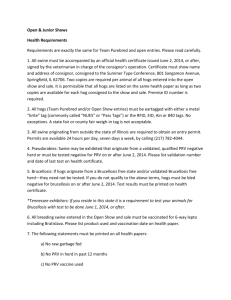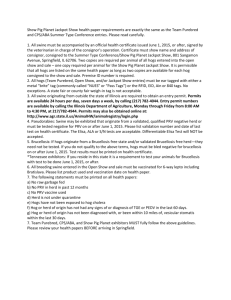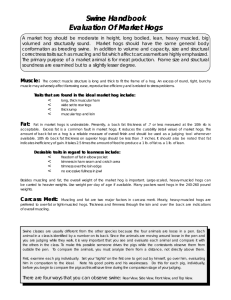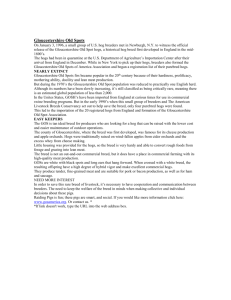Marketing Swine
advertisement
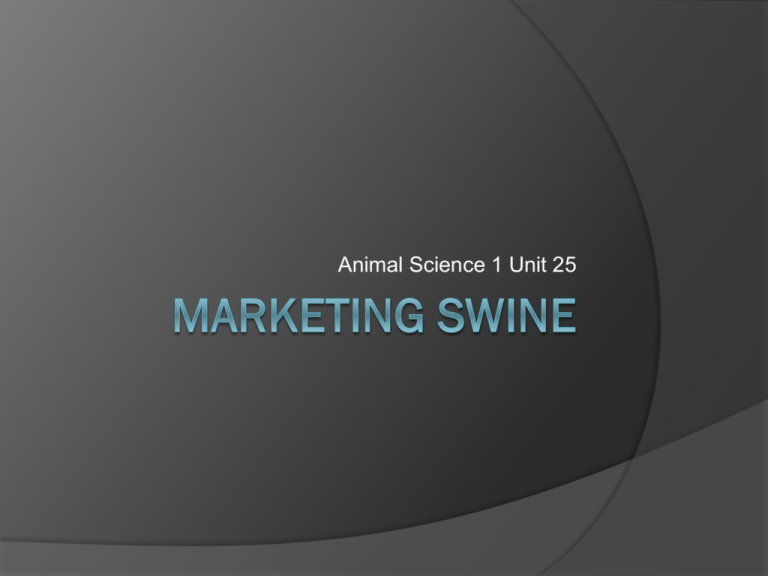
Animal Science 1 Unit 25 Objectives Describe 3 methods of marketing hogs List and describe the grades of market hogs List and describe grades of feeder pigs Kinds of Markets Direct Terminal Auction Some producers practice group marketing through one of the above 3 methods Direct Markets Involves selling to a packing plant, order buyers or country buying station Accounts for the majority of the hogs sold in the US Producers deal directly with buyer and must possess selling skills and knowledge of the markets to be successful in getting the best price Advantages Shorter transport distances Less animal shrinkage Terminal Markets Hogs are consigned to a commission firm Less than 1% of the slaughter hogs sold in the US Trend in recent years has been away from terminal markets and toward direct marketing Usually several buyers competing for hogs Prices may vary more widely than in direct market due to the number of hogs coming on the market on a given day Auction Markets Important in some areas Small percentage of hog sales Not widely uses in the major hog producing states Producers are limited to sale days only Low transportation cost and shrinkage due to markets being in the area Selling cost involved with terminal and auction markets are commission, insurance, yardage and feed Group Marketing (X) Established by major farm organizations Group negotiates contracts with packers to supply hogs Basic purpose is to obtain higher prices Biggest advantage is increased bargaining power Slaughter & Feeder Swine Slaughter swine- Those that are killed and sold as meat Feeder swine- Those that are sold and fed to higher weights before slaughter 5 Classes of Slaughter and Feeder Swine Barrow Gilt Sow Boar Stag Grades Only given slaughter barrows and gilts based on carcass quality and yield of the four lean cuts Ham, Loin, Picnic Shoulder, Boston Butt Acceptable Carcasses Bellies are at least slightly thick overall and not less than 0.6 thick at any point Other factors used to determine quality are Amount and distribution of external finish Firmness of fat and muscle Official USDA Grades US No. 1—less than 1.00 inch of BF US No. 2—1.00 to 1.24 inches of BF US No. 3—1.25 to 1.49 inches of BF US No. 4— 1.50 inches or over of BF US Utility Estimated back fat thickness over the last rib and muscling scores are used to determine the official grade Fig 25-4 p. 479 Slaughter Barrows and Gilt Grade Descriptions See p. 479 Slaughter Sow Grades US No. 1– 1.5 to 1.9 inches of BF US No. 2– 1.9 to 2.3 inches of BF US No. 3– 2.3 or more inches of BF Medium –1.1 to 1.5 inches of BF Cull– Less than 1.1 inches of BF See text p. 479-480 for descriptions of the US Slaughter Sow Grades Feeder Pig Grades US No. 1 US No. 2 US No. 3 US No. 4 US Utility US Cull Fig 25-5 p. 481 P. 481 for descriptions Weight and Time to Sell Traditional recommendation is to sell slaughter hogs at 200-220 pounds This was based on (1) research indicated that feed costs per pound of gain increased rapidly above 220 pounds and (2) much of the weight added over 220 pounds was fat. Recent research however indicates that 4 factors should be considered 1. 2. 3. 4. Type of Hog Hog-feed price ratio Amount of discount for heavier hogs The time of year when hogs are marketed See p. 481-482 Shrinkage Weight loss that occurs during shipping Distance to market is one of the most important factors in determining the amount of shrinkage 2% can be expected regardless of distance due to sorting, handling, loading and hauling and takes place in the first few miles Other factors that increase shrinkage Rough handling Temperature (below 20°F and above 60°F) Summary Most hogs are marketed directly in the US, smaller numbers are marketed through terminal markets and by auction, some group marketing has also been established to help get higher prices Most hogs are sold on the basis of weight Producers of quality hogs can get more by selling on a yield and grade basis Hogs are classified according to sex, weight, and quality. Grades are based on USDA standards and are used for both butcher and feeder hogs. Grades are based upon the quality of lean meat and percent of the 4 lean cuts that the carcass will produce Summary It has been traditionally recommended to market hogs at 200 to 220 pounds However other factors such as hog-feed prices ratio, discounts for heavy hogs and seasonal prices should be considered. Hog prices tend to be lower in early spring and higher in the summer. Shrinkage increases as moving distance increases. Careful handling to reduce stress can also help to reduce shrinkage and other losses. Assignment Rest of the Week Wednesday- Hog Anatomy Quiz Thursday- Watch Hog Slaughter video and complete questions Friday- Complete questions for Unit 25: Discussion Questions 3, 5-9, 12-14 Review 1-12 due Monday Oct 25. Test next Tuesday


